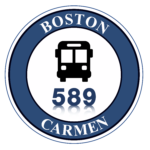New documentary shows how T workers toil while others sleep
February 15, 2012
Boston Globe | Jeremy C. Fox | February 13, 2012
Late each night, more than 100 MBTA workers prowl the tracks of the transit system to find damage and make repairs, ending their workday before most commuters begin theirs.
It’s a largely unseen part of the MBTA, but one that is vital to the system’s maintenance and public safety. Thanks to a new documentary film recently released by the state, those workers and others who labor to make commuters safe are getting some rare attention.
“Boston Under: After Hours” follows the night crew through its shift, as workers deal with the challenges and dangers of the job, but the 44-minute film, available on YouTube, also surveys the history of the country’s first subway system and the safety issues that can arise at any time of day.
Patrick Kineavy, the T’s director of physical infrastructure maintenance who appears in the film, said in a recent phone interview that night crews are usually invisible to the commuting public but work hard to make riders safe, and they take pride in what they do.
“The only way that anyone knows there’s an actual crew out there at night is if there’s a delay in service for some reason,” Kineavy said. “What the public sees is those few times when something happens and there’s a delay.”
Kineavy said the idea for the documentary grew out of a popular article in the Boston Metro about the night crew’s work. A team of filmmakers from the communications office in the state Department of Revenue contacted the MBTA with the idea of digging deeper, so to speak, to show what the crew does.
Filmmakers Peter Olejnik and Edward Peters include personal reflections on the T from person-on-the-street interviews, including familiar criticisms that the T should run later at night, after bars close, or should be more technologically advanced.
The filmmakers include responses to those criticisms, including an interview where state Secretary of Transportation Richard A. Davey explains that while the current subway fare is $1.70 per ride, the actual cost to the T is $3.50 – $3.70. But that cost-per-ride shoots up to $8 – $10 for late-night service, when few are riding the trains, Davey says.
The film highlights women who work in challenging and physically demanding jobs on the night crew, such as welder Paula Pennachio, who talks about the satisfaction of repairing something broken and seeing it look brand new. Val Morris, a trackperson and former trolley conductor, says, “I think when a lot of females see us doing this, then they know they can do it too.”
It also reviews the construction of the original subway in the 1890s with transit historian Bradley H. Clarke, president of the Boston Street Railway Association. The subway was largely dug by hand by thousands of Irish and Italian immigrants, all in two and a half years, he explains.
Clarke says it would take about as long today, despite better technology, due to modern permitting requirements and environmental concerns.
Kineavy, who has worked in the T’s track department since 1982, hopes the documentary will show the riding public the intensive training that track workers undergo and the effort they put into making travelers safe.
Each night from Sunday to Thursday, the track department’s system repair workers walk the tracks performing visual inspections, taking measurements and looking for defects or anomalies. They cover the entire length of the tracks three times a week on the Green Line and twice a week on the Red, Orange, and Blue lines.
These workers list areas needing repair in their quality-control logs and assign each a priority number from one to three. A planning and scheduling coordinator then takes all the logs to schedule work for upcoming shifts.
Because all work needs to be done between 1 and 5 a.m., when the T is closed, to avoid service delays, work that requires four or more hours to complete must be performed over more than one night.
T employees were not required to participate in the film, Kineavy said, but many workers were proud to talk about what they do.
“Our goal out there every night is to create a safe ride for the other T employees and the public,” Kineavy said. “That’s always on our minds, so I hope that comes through [in the film].”
An MBTA spokesman said the authority hopes to host a public screening of the documentary but has not yet set a date.
Click here for the full film on YouTube.com.



Recent Comments